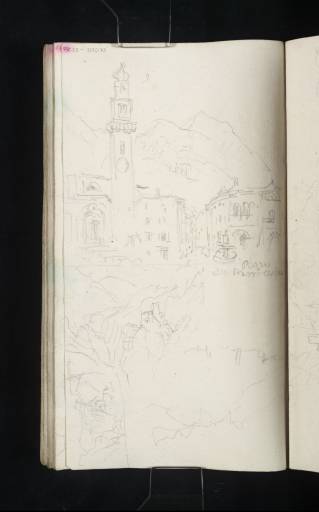Finberg later annotated his 1909
Inventory entry (‘“Piazza alla Parrocessia (?).”’): ‘? Innsbruck’.
1 For the latter, see under folio 17 recto (
D31629). However, the subject here is from earlier on Turner’s northward journey, showing the campanile of the Santissimo Redentore church in Levico Terme, in the Valsugana section of the Brenta Valley; it survives much as shown, but the present church of Santissimo Redentore is a later nineteenth-century replacement of the smaller building to the left here.
The viewpoint is now the Piazza della Chiesa, which Turner labelled as noted by Finberg, perhaps attempting ‘parrocchiale’ or some variant on the Italian for ‘parish’. Trees obstruct the immediately equivalent view across the small, steep square at the bottom of the Via Monsignor D. Caproni, but from a few steps down the hill the narrow Via Regia comes into view to the east; what seems to be a fountain or pump does not survive in front of the dark archway, with its row of arched windows above, at the entrance to the Via Trieste.
Today the substantial building to the right of the tower bears an inscription commemorating Napoleon’s passing through the town in 1796. Although Turner naturally took an interest in one of the key figures of the age,
2 there is no sign he was aware of a connection in this case, and likely recorded the scene simply for the ‘ameno e ospitale’ qualities appreciated by the Emperor, in the plaque’s wording. Levico Terme lay on Turner’s route westwards between Borgo Valsugana (see folios 18 verso–19 recto;
D31632–D31633) and Trento (see under folio 37 recto (
D31669). See also the verso and folio 22 recto (
D31636,
D31639) for labelled views nearby; folio 21 verso (
D31638) may include another. Although Finberg read an inscription on folio 88 recto (
D31768) as ‘Levico’, the subject may be elsewhere.
Separated by a horizontal pencil line, there are three unidentified mountain subjects below. One, inverted like the Levico view in relation to the sketchbook’s foliation, includes a castle; another, the other way up, shows loosely rendered peaks beyond distant buildings, and a third, squeezed in at right-angles at the bottom left, is perhaps a variant on the first. Over half of the pages in this book comprise relatively slight sketches from Turner’s homeward route north through the valleys of the Alps via Trento, Bolzano (Bozen) and Innsbruck. As set out in the Introduction, although his overall itinerary is clear from many identified subjects, they were are not drawn in a single sequence, making the rugged scenes between them difficult to place.

